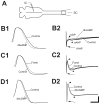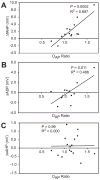Cyclic AMP stimulates neurite outgrowth of lamprey reticulospinal neurons without substantially altering their biophysical properties
- PMID: 23603516
- PMCID: PMC3672336
- DOI: 10.1016/j.neuroscience.2013.04.016
Cyclic AMP stimulates neurite outgrowth of lamprey reticulospinal neurons without substantially altering their biophysical properties
Abstract
Reticulospinal (RS) neurons are critical for initiation of locomotor behavior, and following spinal cord injury (SCI) in the lamprey, the axons of these neurons regenerate and restore locomotor behavior within a few weeks. For lamprey RS neurons in culture, experimental induction of calcium influx, either in the growth cone or cell body, is inhibitory for neurite outgrowth. Following SCI, these neurons partially downregulate calcium channel expression, which would be expected to reduce calcium influx and possibly provide supportive conditions for axonal regeneration. In the present study, it was tested whether activation of second messenger signaling pathways stimulates neurite outgrowth of lamprey RS neurons without altering their electrical properties (e.g. spike broadening) so as to possibly increase calcium influx and compromise axonal growth. First, activation of cAMP pathways with forskolin or dbcAMP stimulated neurite outgrowth of RS neurons in culture in a PKA-dependent manner, while activation of cGMP signaling pathways with dbcGMP inhibited outgrowth. Second, neurophysiological recordings from uninjured RS neurons in isolated lamprey brain-spinal cord preparations indicated that dbcAMP or dbcGMP did not significantly affect any of the measured electrical properties. In contrast, for uninjured RS neurons, forskolin increased action potential duration, which might have increased calcium influx, but did not significantly affect most other electrical properties. Importantly, for injured RS neurons during the period of axonal regeneration, forskolin did not significantly alter their electrical properties. Taken together, these results suggest that activation of cAMP signaling by dbcAMP stimulates neurite outgrowth, but does not alter the electrical properties of lamprey RS neurons in such a way that would be expected to induce calcium influx. In conclusion, our results suggest that activation of cAMP pathways alone, without compensation for possible deleterious effects on electrical properties, is an effective approach for stimulating axonal regeneration of RS neuron following SCI.
Copyright © 2013 IBRO. Published by Elsevier Ltd. All rights reserved.
Figures











Similar articles
-
Regulation of axonal regeneration following spinal cord injury in the lamprey.J Neurophysiol. 2017 Sep 1;118(3):1439-1456. doi: 10.1152/jn.00986.2016. Epub 2017 May 3. J Neurophysiol. 2017. PMID: 28469003 Free PMC article.
-
Spinal Cord Injury Significantly Alters the Properties of Reticulospinal Neurons: I. Biophysical Properties, Firing Patterns, Excitability, and Synaptic Inputs.Cells. 2021 Jul 29;10(8):1921. doi: 10.3390/cells10081921. Cells. 2021. PMID: 34440690 Free PMC article.
-
Spinal cord injury significantly alters the properties of reticulospinal neurons: delayed repolarization mediated by potassium channels.J Neurophysiol. 2023 Nov 1;130(5):1265-1281. doi: 10.1152/jn.00251.2023. Epub 2023 Oct 11. J Neurophysiol. 2023. PMID: 37820016 Free PMC article.
-
The role of cAMP and its downstream targets in neurite growth in the adult nervous system.Neurosci Lett. 2017 Jun 23;652:56-63. doi: 10.1016/j.neulet.2016.12.033. Epub 2016 Dec 15. Neurosci Lett. 2017. PMID: 27989572 Review.
-
Serotonin regulation of neurite outgrowth in identified neurons from mature and embryonic Helisoma trivolvis.Perspect Dev Neurobiol. 1998;5(4):373-87. Perspect Dev Neurobiol. 1998. PMID: 10533526 Review.
Cited by
-
Lampreys and spinal cord regeneration: "a very special claim on the interest of zoologists," 1830s-present.Front Cell Dev Biol. 2023 May 9;11:1113961. doi: 10.3389/fcell.2023.1113961. eCollection 2023. Front Cell Dev Biol. 2023. PMID: 37228651 Free PMC article.
-
Serotonin inhibits axonal regeneration of identifiable descending neurons after a complete spinal cord injury in lampreys.Dis Model Mech. 2019 Feb 20;12(2):dmm037085. doi: 10.1242/dmm.037085. Dis Model Mech. 2019. PMID: 30709851 Free PMC article.
-
Full regeneration of descending corticotropin-releasing hormone axons after a complete spinal cord injury in lampreys.Comput Struct Biotechnol J. 2022 Oct 18;20:5690-5697. doi: 10.1016/j.csbj.2022.10.020. eCollection 2022. Comput Struct Biotechnol J. 2022. PMID: 36320936 Free PMC article.
-
Regulation of axonal regeneration following spinal cord injury in the lamprey.J Neurophysiol. 2017 Sep 1;118(3):1439-1456. doi: 10.1152/jn.00986.2016. Epub 2017 May 3. J Neurophysiol. 2017. PMID: 28469003 Free PMC article.
-
Mechanisms of Axon Elongation Following CNS Injury: What Is Happening at the Axon Tip?Front Cell Neurosci. 2020 Jul 3;14:177. doi: 10.3389/fncel.2020.00177. eCollection 2020. Front Cell Neurosci. 2020. PMID: 32719586 Free PMC article.
References
-
- Bandtlow CE, Schmidt MF, Hassinger TD, Schwab ME, Kater SB. Role of intracellular calcium in NI-35 evoked collapse of neuronal growth cones. Science. 1993;259:80–83. - PubMed
-
- Bernau NA, Puzdrowski RL, Leonard RB. Identification of the midbrain locomotor region and its relation to descending locomotor pathways in the Atlantic stingray, Dasyatis sabina. Brain Res. 1991;557:83–94. - PubMed
-
- Bhatt DH, Otto SJ, Depoister B, Fetcho JR. Cyclic AMP-induced repair of zebrafish spinal circuits. Science. 2004;305:254–258. - PubMed
Publication types
MeSH terms
Substances
Grants and funding
LinkOut - more resources
Full Text Sources
Other Literature Sources

